Electrohydrodynamic Printing of PCL@CsPbBr3 Composite Fibers with High Luminescence for Flexible Displays
Abstract
:1. Introduction
2. Materials and Methods
2.1. Materials
2.2. Methods
2.2.1. Synthesis of Cs-Oleate
2.2.2. Synthesis of CsPbBr3 PQDs
2.2.3. Purification
2.2.4. Synthesis of PCL@CsPbBr3
2.2.5. Preparation of Composite Fiber
2.2.6. High-Resolution Pattern Printing
2.2.7. Flexible Display Applications
2.2.8. Analytical Methods
3. Results and Discussion
3.1. XRD Phase Analysis
3.2. TEM Morphological Analysis
3.3. Optical and Surface Performance Analysis
3.4. Water Stability Test
3.5. Structure and Morphology Analysis of PCL@CsPbBr3 Composite Fiber
3.6. Mechanical Properties Analysis
4. Conclusions
Author Contributions
Funding
Institutional Review Board Statement
Informed Consent Statement
Data Availability Statement
Conflicts of Interest
References
- Zhao, Z.; Liu, K.; Liu, Y.; Guo, Y.; Liu, Y. Intrinsically flexible displays: Key materials and devices. Natl. Sci. Rev. 2022, 9, nwac090. [Google Scholar] [CrossRef] [PubMed]
- Yan, K.; Li, J.; Pan, L.; Shi, Y. Inkjet printing for flexible and wearable electronics. APL Mater. 2020, 8, 120705. [Google Scholar] [CrossRef]
- Wang, J.; Lee, P. Progress and Prospects in Stretchable Electroluminescent Devices. Nanophotonics 2017, 6, 435–451. [Google Scholar] [CrossRef] [Green Version]
- Yelzhanova, Z.; Nigmetova, G.; Aidarkhanov, D.; Daniyar, B.; Baptayev, B.; Balanay, M.P.; Jumabekov, A.N.; Ng, A. A morphological study of solvothermally grown SnO2 nanostructures for application in perovskite solar cells. Nanomaterials 2022, 12, 1686. [Google Scholar] [CrossRef] [PubMed]
- Zhao, J.; Chi, Z.; Yang, Z.; Chen, X.; Arnold, M.S.; Zhang, Y.; Xu, J.; Chi, Z.; Aldred, M.P. Recent developments of truly stretchable thin film electronic and optoelectronic devices. Nanoscale 2018, 10, 5764–5792. [Google Scholar] [CrossRef] [PubMed]
- Kong, W.-W.; Zhou, C.-G.; Dai, K.; Jia, L.-C.; Yan, D.-X.; Li, Z.-M. Highly stretchable and durable fibrous strain sensor with growth ring-like spiral structure for wearable electronics. Compos. Part B Eng. 2021, 225, 109275. [Google Scholar] [CrossRef]
- Wang, B.; Thukral, A.; Xie, Z.; Liu, L.; Zhang, X.; Huang, W.; Yu, X.; Yu, C.; Marks, T.J.; Facchetti, A. Flexible and stretchable metal oxide nanofiber networks for multimodal and monolithically integrated wearable electronics. Nat. Commun. 2020, 11, 2405. [Google Scholar] [CrossRef] [PubMed]
- Zhang, M.; Zheng, Z.; Fu, Q.; Chen, Z.; He, J.; Zhang, S.; Yan, L.; Hu, Y.; Luo, W. Growth and characterization of all-inorganic lead halide perovskite semiconductor CsPbBr3 single crystals. CrystEngComm 2017, 19, 6797–6803. [Google Scholar] [CrossRef]
- Lin, Y.; Zheng, X.; Shangguan, Z.; Chen, G.; Huang, W.; Guo, W.; Fan, X.; Yang, X.; Zhao, Z.; Wu, T.; et al. All-inorganic encapsulation for remarkably stable cesium lead halide perovskite nanocrystals: Toward full-color display applications. J. Mater. Chem. C 2021, 9, 12303–12313. [Google Scholar] [CrossRef]
- Liao, M.; Shan, B.; Li, M. In situ Raman spectroscopic studies of thermal stability of all-inorganic cesium lead halide (CsPbX3, X = Cl, Br, I) perovskite nanocrystals. J. Phys. Chem. Lett. 2019, 10, 1217–1225. [Google Scholar] [CrossRef] [PubMed]
- Cheng, D.; Yang, Z.; Liang, Y. Preparation and Energy Storage Performance of Perovskite Luminescent Materials by an Electrochemiluminescence Method. Adsorpt. Sci. Technol. 2022, 2022, 3092941. [Google Scholar]
- Zhou, R.; Cheng, C.; Wang, X.; Nie, K.; Wu, J.; Wu, M.; Duan, X.; Hu, Z.; Huq; Wang, H.; et al. Metal halide perovskite nanocrystals with enhanced photoluminescence and stability toward anti-counterfeiting high-performance flexible fibers. Nano Res. 2022, 16, 3542–3551. [Google Scholar] [CrossRef]
- Zhang, L.; Zhang, Y.; He, W.; Peng, H.; Dai, Q. CsPbBr3 perovskite nanowires and their optical properties. Opt. Mater. 2020, 109, 110399. [Google Scholar] [CrossRef]
- Wang, Z.; Zhang, J.; Guo, W.; Xiang, W.; Hagfeldt, A. Formation and Stabilization of Inorganic Halide Perovskites for Photovoltaics. Matter 2021, 4, 528–551. [Google Scholar] [CrossRef]
- Zhao, C.; Li, Y.; Ye, W.; Shen, X.; Wen, Z.; Yuan, X.; Cao, Y.; Ma, C. Ligand-Free CsPbBr3 Perovskite Quantum Dots in Silica-Aerogel Composites with Enhanced Stability for w-LED and Display by Substituting Pb2+ with Pr3+ or Gd3+ Ions. Adv. Opt. Mater. 2022, 10, 2102200. [Google Scholar] [CrossRef]
- Meyns, M.; Peralvarez, M.; Jungemann, A.H.; Hertog, W.; Lbanez, M.; Nafria, R.; Genc, A.; Arbiol, J.; Kovalenko, M.V.; Carreras, J.; et al. Polymer-Enhanced Stability of Inorganic Perovskite Nanocrystals and Their Application in Color Conversion LEDs. ACS Appl. Mater. Interfaces 2016, 8, 19579–19586. [Google Scholar] [CrossRef] [Green Version]
- Demkiv, T.M.; Myagkota, S.V.; Malyi, T.; Pushak, A.S.; Vistovskyy, V.V.; Yakibchuk, P.M.; Shapoval, O.V.; Mitina, N.E.; Zaichenko, A.S.; Voloshinovskii, A.S. Luminescence properties of CsPbBr3 nanocrystals dispersed in a polymer matrix. J. Lumin. 2018, 198, 103–107. [Google Scholar] [CrossRef]
- Li, H.; Zhang, B.; Zhang, B.; Bala, H.; An, X.; Sha, N.; Sun, Z.; Zhang, W.; Zhang, Z. Core-shell structuredCsPbBr3/Sn-TiO2 nanocrystals for visible-light-driven photocatalyst in aqueous solution. Appl. Surf. Sci. 2022, 599, 153937. [Google Scholar] [CrossRef]
- Kar, M.R.; Ray, S.; Patra, B.K.; Bhaumik, S. State of the art and prospects of metal halide perovskite core@shell nanocrystals and nanocomposites. Mater. Today Chem. 2021, 20, 100424. [Google Scholar] [CrossRef]
- Numata, Y.; Sanehira, Y.; Miyasaka, T. Impacts of heterogeneous TiO2 and Al2O3 composite mesoporous scaffold on formamidinium lead trihalide perovskite solar cells. ACS Appl. Mater. Interfaces 2016, 8, 4608–4615. [Google Scholar] [CrossRef]
- Li, Q.F.; Wang, J.T.; Tian, B.; Kong, S.; Wang, T.; Wang, Z. Hybridization of CsPbBr3 perovskite nanocrystals with polymer nanofiber to improve their luminescence stability. Eur. J. Inorg. Chem. 2018, 2018, 4215–4220. [Google Scholar] [CrossRef]
- Hu, X.; Xu, Y.; Wang, J.; Ma, J.; Wang, L.; Jiang, W. In Situ Fabrication of Superfine Perovskite Composite Nanofibers with Ultrahigh Stability by One-Step Electrospinning Toward White Light-Emitting Diode. Adv. Fiber Mater. 2022, 5, 183–197. [Google Scholar] [CrossRef]
- Ye, D.; Ding, Y.; Duan, Y.; Su, J.; Yin, Z.; Huang, Y.A. Large-Scale Direct-Writing of Aligned Nanofibers for Flexible Electronics. Nano Micro 2018, 14, 1703521. [Google Scholar] [CrossRef]
- Qaid, S.M.; Ghaithan, H.M.; AlHarbi, K.K.; AI-Asbahi, B.A.; Aldwayyan, A.S. Enhancement of light amplification of CsPbBr3 perovskite quantum dot films via surface encapsulation by PMMA polymer. Polymers 2021, 13, 2574. [Google Scholar] [CrossRef] [PubMed]
- Ercan, E.; Tsai, P.C.; Chen, J.Y.; Lam, J.Y.; Hsu, L.C.; Chueh, C.C.; Chen, W.C. Stretchable and Ambient Stable Perovskite/Polymer Luminous Hybrid Nanofibers of Multicolor Fiber Mats and Their White LED Applications. ACS Appl. Mater. Interfaces 2019, 11, 23605–23615. [Google Scholar] [CrossRef] [PubMed]
- Shen, J.; Wang, Y.; Zhu, Y.; Gong, Y.; Li, C. A polymer-coated template-confinement CsPbBr3 perovskite quantum dot composite. Nanoscale 2021, 13, 6586–6591. [Google Scholar] [CrossRef] [PubMed]
- Kim, H.; So, S.; Ribbe, A.; Liu, Y.; Hu, W.; Duzhko, V.V.; Hayward, R.C.; Emrick, T. Functional polymers for growth and stabilization of CsPbBr3 perovskite nanoparticles. Chem. Commun. 2019, 55, 1833–1836. [Google Scholar] [CrossRef]
- Ren, Y.; Wang, S.; Liu, R.; Dai, J.; Liu, X.; Yu, J. A novel route towards well-dispersed short nanofibers and nanoparticles via electrospinning. RSC Adv. 2016, 6, 30139–30147. [Google Scholar] [CrossRef]
- Bi, H.; Liu, F.; Wang, M.; Mao, Z.; Zhai, Y.; Li, W.; Wang, S.; Zhang, M. Construction of ultra-stable perovskite-polymer fibre membranes by electrospinning technology and its application to light-emitting diodes. Polym. Int. 2021, 70, 90–95. [Google Scholar] [CrossRef]
- Xiong, J.; Wang, H.; Lan, X.; Wang, Y.; Wang, Z.; Bai, J.; Ou, W.; Cai, N.; Wang, W.; Tang, Y. Fabrication of bioinspired grid-crimp micropatterns by melt electrospinning writing for bone–ligament interface study. Biofabrication 2022, 14, 025008. [Google Scholar] [CrossRef]
- Pidluzhna, A.; Lvaniuk, K.; Stakhira, P.; Hotra, Z.; Chapran, M.; Ulanski, J.; Tynkevych, O.; Khalavka, Y.; Baryshnikov, G.V.; Minaev, B.F.; et al. Multi-channel electroluminescence of CdTe/CdS core-shell quantum dots implemented into a QLED device. Dye. Pigment. 2019, 162, 647–653. [Google Scholar] [CrossRef]
- Jiang, D.-H.; Tsal, Y.-H.; Veeramuthu, L.; Liang, F.-C.; Chen, L.-C.; Lin, C.C.; Satoh, T.; Tung, S.-H.; Kuo, C.-C. Novel ultra-stable and highly luminescent white light-emitting diodes from perovskite quantum dots—Polymer nanofibers through biaxial electrospinning. APL Mater. 2019, 7, 111105. [Google Scholar] [CrossRef]
- Ivaniuk, K.; Cherpak, V.; Stakhira, P.; Baryshnikov, G.; Minaev, B.; Hotra, Z.; Turyk, P.; Zhydachevskii, Y.; Volyniuk, D.; Aksimentyeva, O.; et al. BaZrO3 perovskite nanoparticles as emissive material for organic/inorganic hybrid light-emitting diodes. Dye. Pigment. 2017, 145, 399–403. [Google Scholar] [CrossRef] [Green Version]
- Jiang, M.-C.; Pan, C.-Y. Research on the stability of luminescence of CsPbBr3 and Mn: CsPbBr3 PQDs in polar solution. RSC Adv. 2022, 12, 15420–15426. [Google Scholar] [CrossRef] [PubMed]
- Bhattarai, N.; Li, Z.; Cunn, J.; Leung, M.; Cooper, A.; Edmondson, D.; Veiseh, O.; Chen, M.-H.; Zhang, Y.; Ellenbogen, R.G.; et al. Natural-synthetic polyblend nanofibers for biomedical applications. Adv. Mater. 2009, 21, 2792–2797. [Google Scholar] [CrossRef]
- Aznar-Gadea, E.; Sanchez-Alarcon, I.; Soosaimanickam, A.; Rodriguez-Canto, P.; Perez-Pla, F.; Martinez-Pastor, J.; Abargues, R. Molecularly imprinted nanocomposites of CsPbBr3 nanocrystals: An approach towards fast and selective gas sensing of explosive taggants. J. Mater. Chem. C 2022, 10, 1754–1766. [Google Scholar] [CrossRef]
- Kang, G.; Lee, H.; Moon, J.; Jang, H.-S.; Cho, D.-S.; Byun, D. Electrohydrodynamic Jet-Printed MAPbBr3 Perovskite/Polyacrylonitrile Nanostructures for Water-Stable, Flexible, and Transparent Displays. ACS Appl. Nano Mater. 2022, 5, 6726–6735. [Google Scholar] [CrossRef]


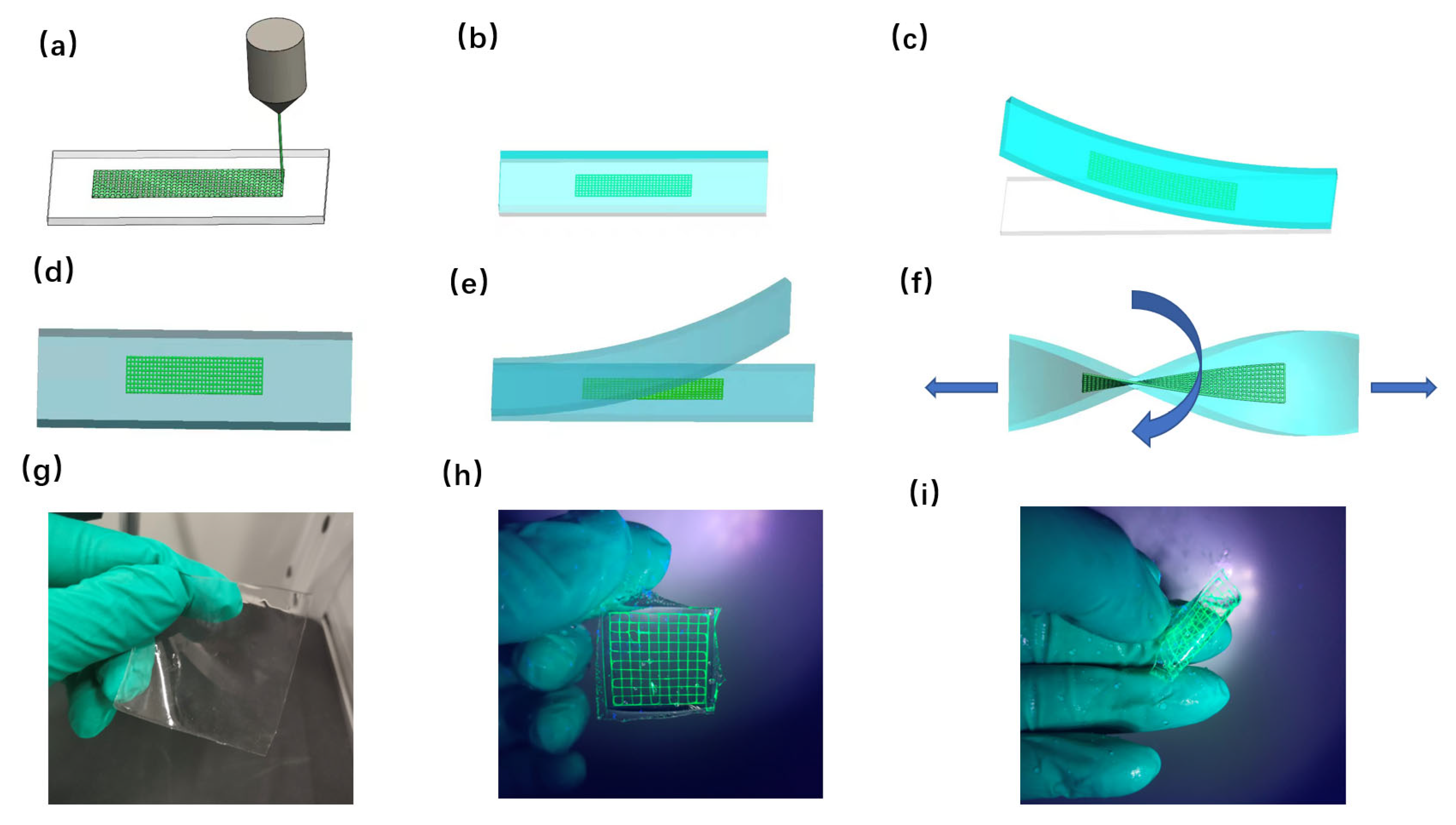
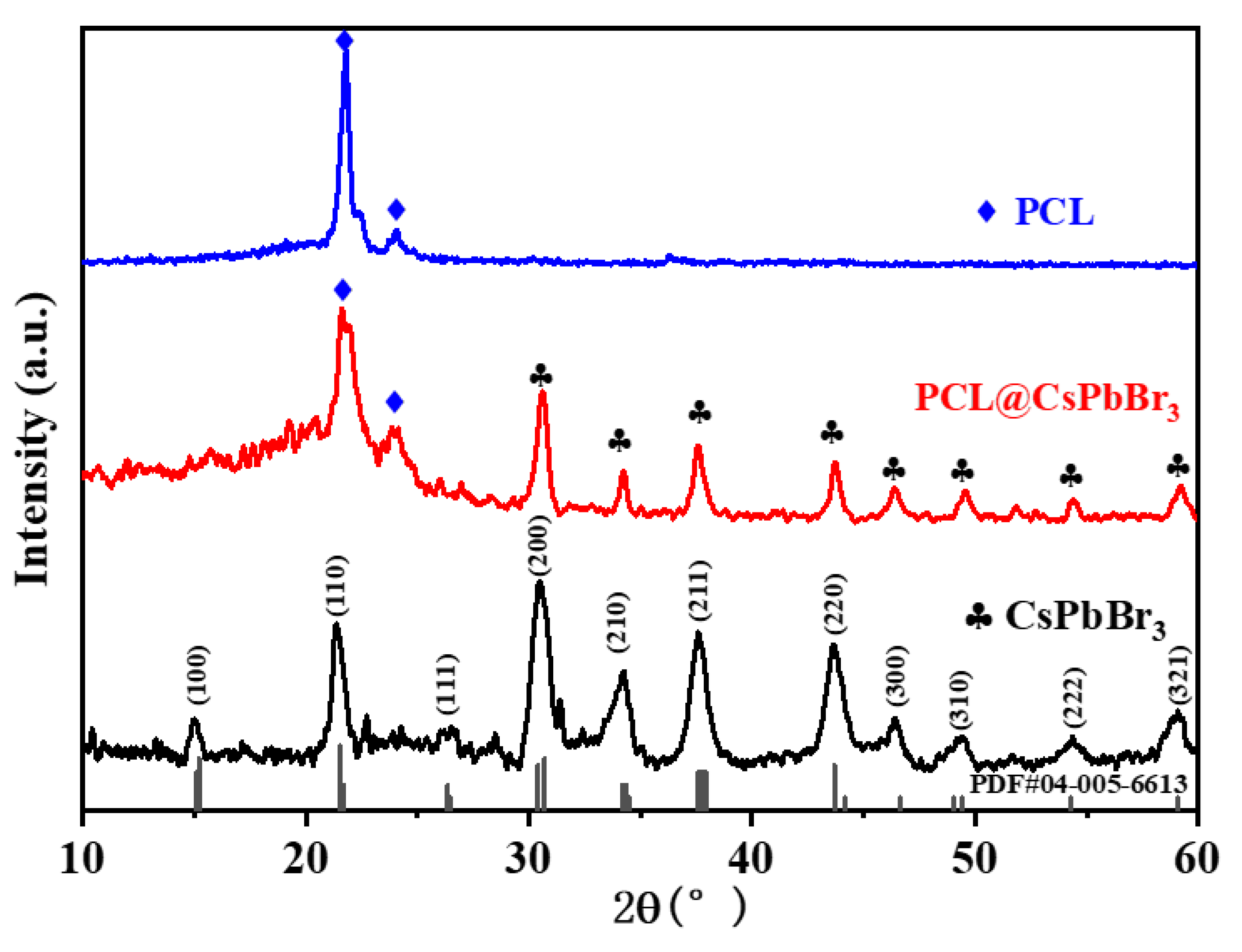

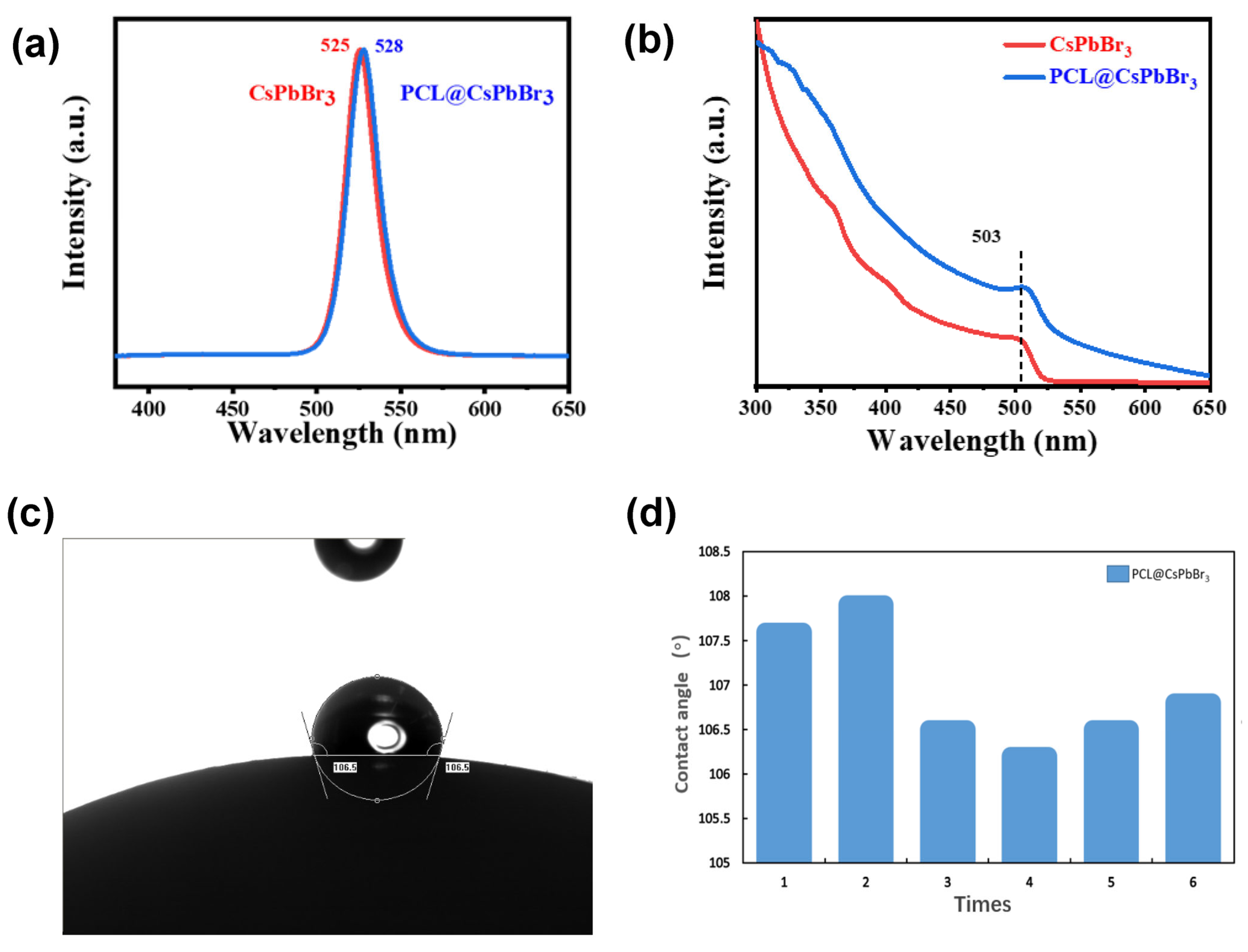
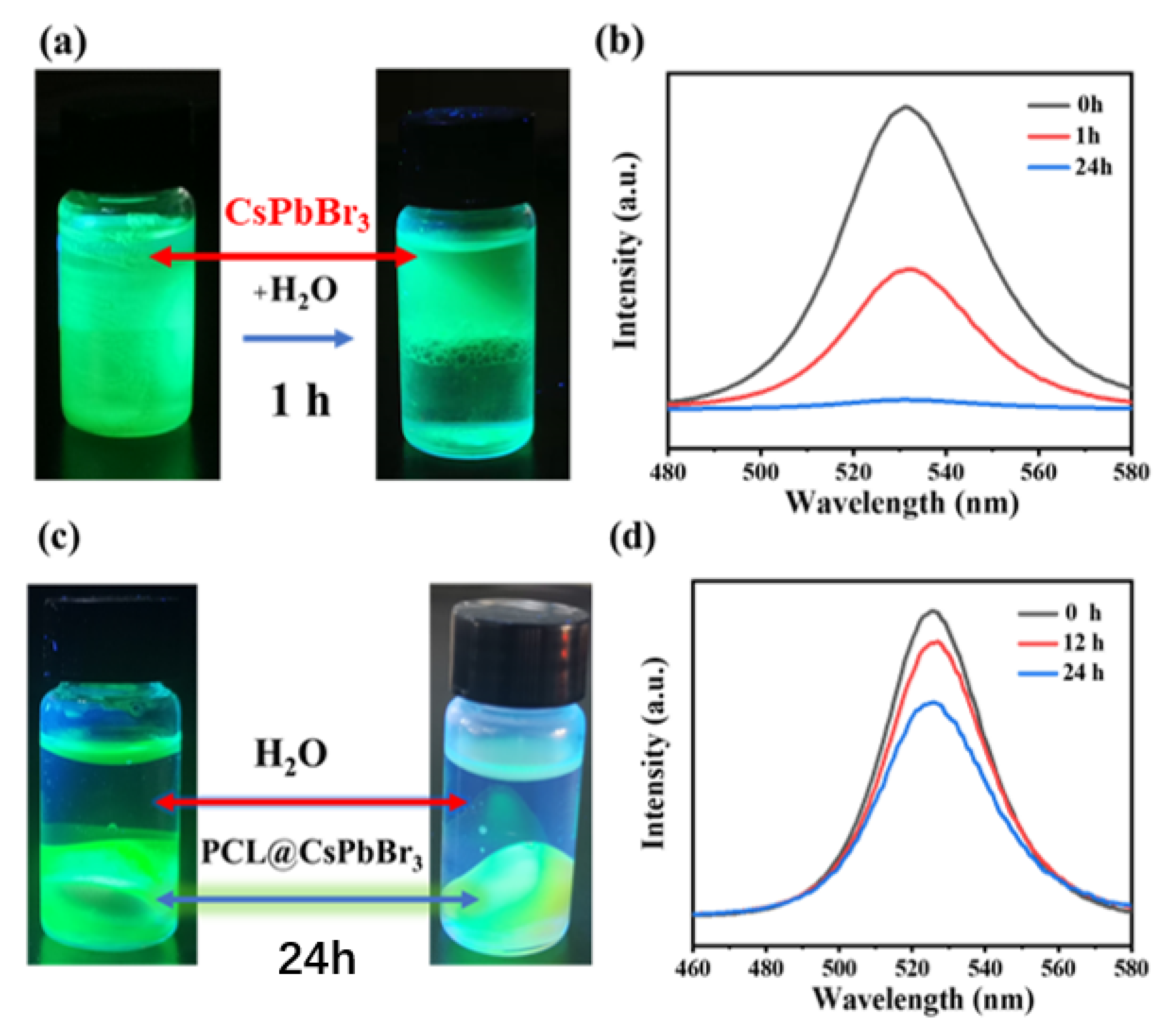
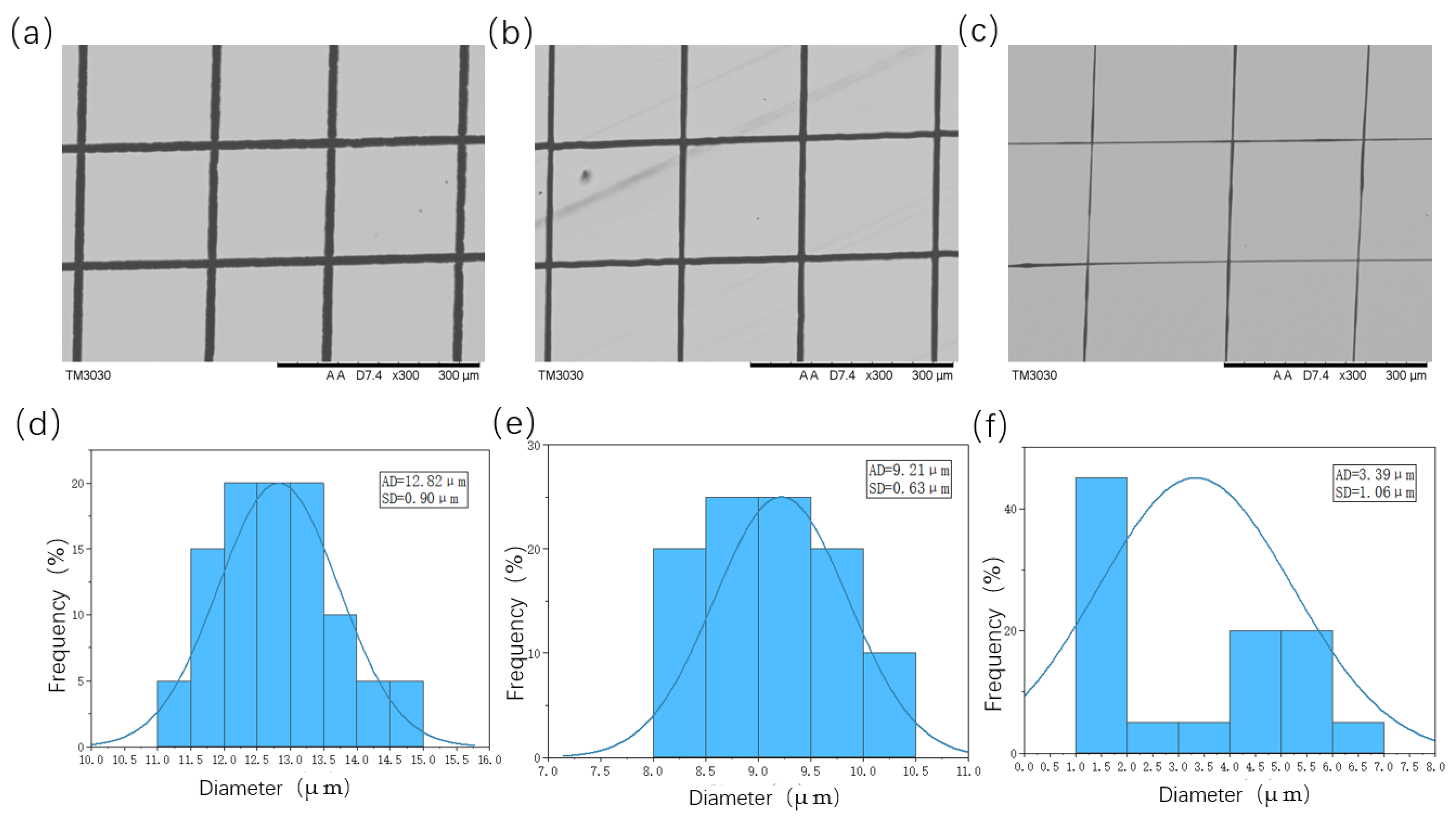

Disclaimer/Publisher’s Note: The statements, opinions and data contained in all publications are solely those of the individual author(s) and contributor(s) and not of MDPI and/or the editor(s). MDPI and/or the editor(s) disclaim responsibility for any injury to people or property resulting from any ideas, methods, instructions or products referred to in the content. |
© 2023 by the authors. Licensee MDPI, Basel, Switzerland. This article is an open access article distributed under the terms and conditions of the Creative Commons Attribution (CC BY) license (https://creativecommons.org/licenses/by/4.0/).
Share and Cite
Liu, M.; Lin, C.; Ou, W.; Wang, H.; Pan, C.; Ji, Y.; Zheng, H. Electrohydrodynamic Printing of PCL@CsPbBr3 Composite Fibers with High Luminescence for Flexible Displays. Coatings 2023, 13, 500. https://doi.org/10.3390/coatings13030500
Liu M, Lin C, Ou W, Wang H, Pan C, Ji Y, Zheng H. Electrohydrodynamic Printing of PCL@CsPbBr3 Composite Fibers with High Luminescence for Flexible Displays. Coatings. 2023; 13(3):500. https://doi.org/10.3390/coatings13030500
Chicago/Turabian StyleLiu, Maolin, Changqing Lin, Weicheng Ou, Han Wang, Chunyang Pan, Yuchen Ji, and Hehui Zheng. 2023. "Electrohydrodynamic Printing of PCL@CsPbBr3 Composite Fibers with High Luminescence for Flexible Displays" Coatings 13, no. 3: 500. https://doi.org/10.3390/coatings13030500



